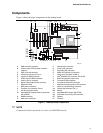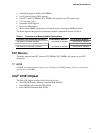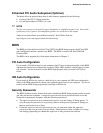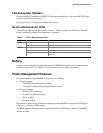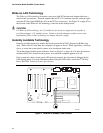Intel Desktop Board D815EEA Product Guide
14
PCI Enhanced IDE Interface
The PCI enhanced IDE interface handles the exchange of information between the processor and
peripheral devices like hard disks, CD-ROM drives, and Iomega ZIP
†
drives inside the computer.
The interface supports:
• Up to four IDE devices (such as hard drives)
• ATAPI devices (such as CD-ROM drives)
• PIO Mode 3 and PIO Mode 4 devices
• Ultra ATA/33, Ultra ATA/66, and Ultra ATA/100 protocols
• Support for laser servo (LS-120) drives
Expansion Slots
The desktop board has seven add-in board connectors: five PCI expansion slots, one AGP
universal connector, and one CNR connector. The seven connectors support only six expansion
cards because the CNR slot and PCI slot 5 are shared and cannot be used simultaneously.
Accelerated Graphics Port (AGP)
The AGP is a high-performance interface for graphics-intensive applications such as 3D graphics.
AGP is independent of the PCI bus and is intended for use with graphical display devices. The
AGP universal connector supports AGP 1X, 2X, and 4X. The AGP universal connector also
supports GPA and DVI add-in cards.
An AGP card retention mechanism (RM) is included with the boxed desktop board. Installation
instructions are presented in Chapter 2.
Audio Subsystem (Optional)
The board offers two AC ’97 V 1.03 compliant audio subsystems. Both audio subsystems include
these features:
• Split digital/analog architecture for improved S/N (signal-to-noise) ratio: ≥ 85dB
• Power management support for APM 1.2 and ACPI 1.0 (driver dependent)
• 3-D stereo enhancement
Basic Audio Subsystem (Optional)
The basic audio subsystem consists of the following:
• Intel 82801BA I/O Controller Hub (ICH2)
• Analog Devices AD1885 analog codec






